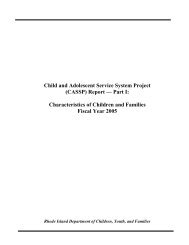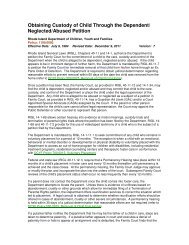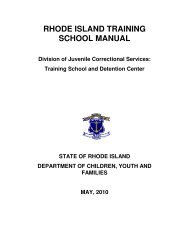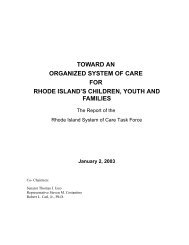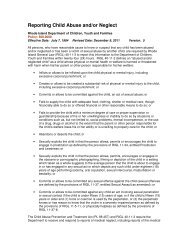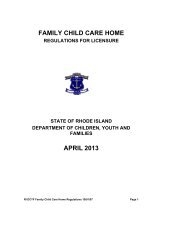system of care for rhode island's children, youth and families
system of care for rhode island's children, youth and families
system of care for rhode island's children, youth and families
Create successful ePaper yourself
Turn your PDF publications into a flip-book with our unique Google optimized e-Paper software.
CHAPTER 2: COMMUNITY-STATE PREVENTION<br />
PARTNERSHIPS/ROLE OF THE CHILDREN’S CABINET<br />
Community <strong>and</strong> State Leaders clearly recognize the important role prevention services play<br />
in the <strong>system</strong> <strong>of</strong> <strong>care</strong> <strong>and</strong> in supporting <strong>children</strong>, <strong>youth</strong>, <strong>and</strong> <strong>families</strong> <strong>for</strong> success. The<br />
promotion <strong>of</strong> emotional <strong>and</strong> physical health is a key responsibility <strong>of</strong> the Children’s Cabinet<br />
in partnership with local communities. The <strong>system</strong>’s foundation is the commitment <strong>of</strong> local<br />
communities <strong>and</strong> the State to ensuring that all neighborhoods have strong prevention <strong>and</strong><br />
educational services to support the complex needs <strong>of</strong> their <strong>children</strong> <strong>and</strong> <strong>families</strong>. The<br />
Children’s Cabinet provides leadership in regard to the development <strong>of</strong> a structure by which<br />
collaboration among state agencies is explicitly described <strong>and</strong> implemented, including<br />
dedicating personnel <strong>and</strong> other resources.<br />
The principles <strong>of</strong> family-centered (see Appendix B) <strong>and</strong> culturally competent (see<br />
Appendix C) practice are embedded values in the Ideal System <strong>of</strong> Care’s community-based<br />
prevention services. The <strong>system</strong> ensures that <strong>families</strong> <strong>and</strong> the multiple cultural, linguistic<br />
<strong>and</strong> religious groups that make up the community are viewed as valuable <strong>and</strong> equal partners<br />
at all levels <strong>of</strong> development, implementation <strong>and</strong> service delivery. Built upon CASSP<br />
principles (see Appendix D), this <strong>system</strong> ensures that decisions regarding treatment <strong>and</strong> <strong>care</strong><br />
are made on an individual basis according to the strengths, risks, <strong>and</strong> needs <strong>of</strong> <strong>families</strong> <strong>and</strong><br />
the best interest <strong>of</strong> the child with a recognition <strong>of</strong> available fiscal resources.<br />
Rhode Isl<strong>and</strong>’s Ideal System underst<strong>and</strong>s the role it plays in promoting the mental health <strong>of</strong><br />
<strong>children</strong> as defined by the US Surgeon General 8 . It is a <strong>system</strong> geared at all levels to the<br />
earliest possible intervention, prevention, crisis intervention, <strong>and</strong> family stabilization in order<br />
to provide <strong>children</strong> with the greatest opportunities to achieve <strong>and</strong> maintain good mental<br />
health. It has the capacity to provide services to all <strong>children</strong> <strong>and</strong> <strong>families</strong> at the level 9 , 10<br />
<strong>of</strong><br />
8 “Spanning roughly 20 years, childhood <strong>and</strong> adolescence are marked by dramatic changes in physical,<br />
cognitive, <strong>and</strong> social-emotional skills <strong>and</strong> capacities. Mental health in childhood <strong>and</strong> adolescence is defined by<br />
the achievement <strong>of</strong> expected developmental cognitive, social <strong>and</strong> emotional milestones <strong>and</strong> by secure<br />
attachments, satisfying social relationships, <strong>and</strong> effective coping skills (Surgeon General’s Report, 2000,<br />
p.123)”.<br />
9 The MECA study (Methodology <strong>for</strong> Epidemiology <strong>of</strong> Mental Disorders in Children <strong>and</strong> Adolescents)<br />
estimated that [nationwide] almost 21 percent <strong>of</strong> US <strong>children</strong> ages 9 to 17 had a diagnosable mental or addictive<br />
disorder associated with at least minimum impairment (Surgeon General’s Report, 2000, p.123)”. Eleven<br />
percent <strong>of</strong> <strong>youth</strong> have significant functional impairment. This estimate translates into a total <strong>of</strong> 4 million <strong>youth</strong><br />
who suffer from a major mental illness that results in significant impairments at home, at school <strong>and</strong> with peers<br />
<strong>and</strong> five percent are classified with extreme functional impairment (Surgeon General’s Report, 2000, p.124).<br />
10 The <strong>for</strong>emost finding in the Surgeon General’s report is that [nationwide] most <strong>children</strong> in need <strong>of</strong> mental<br />
health services do not get them (p. 180). The conclusion that a high proportion <strong>of</strong> young people with a<br />
diagnosable mental disorder do not receive any mental health service at all (Burns, et al., 1995; Leaf et al.,<br />
1996) rein<strong>for</strong>ces an earlier report by the US Office <strong>of</strong> Technology Assessment (1986) which indicated that<br />
approximately 70 percent <strong>of</strong> <strong>children</strong> <strong>and</strong> adolescents in need <strong>of</strong> treatment do not receive mental health<br />
services. Only one in five <strong>children</strong> with a serious emotional disturbance used mental health specialty services<br />
although twice as many such <strong>children</strong> received some <strong>for</strong>m <strong>of</strong> mental health intervention (Burns et al, 1995).<br />
Thus, about 75 to 80 percent fail to receive specialty services, <strong>and</strong> the majority <strong>of</strong> these fail to receive any<br />
13





